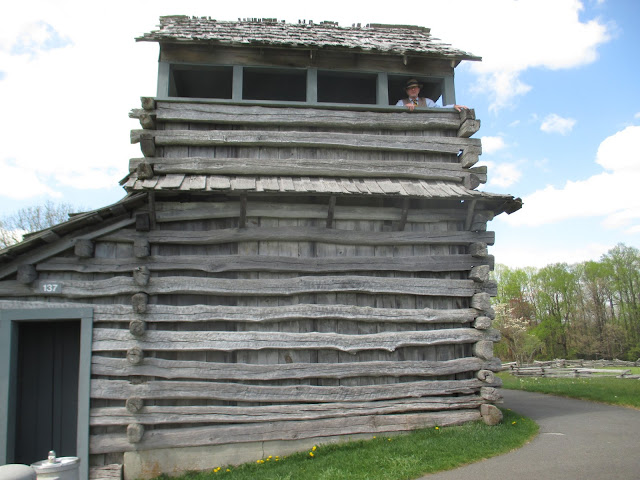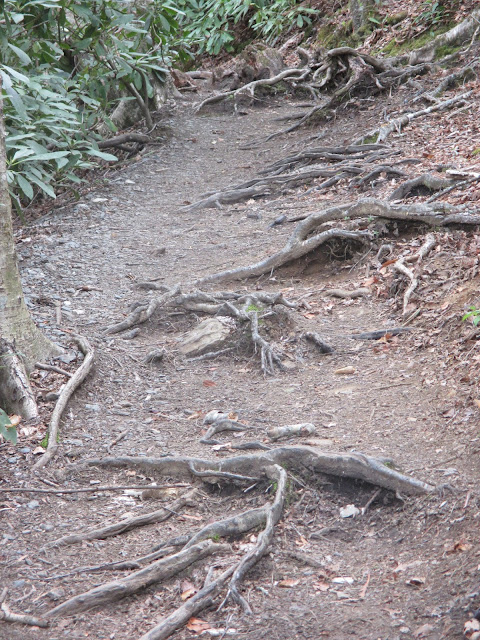April 30-May 2
We made it back to New Jersey on Monday afternoon.
The last two days of the trip were mostly spent driving—about 400 miles from Asheville to Strasburg, Va., on Sunday, and another 300 from Strasburg to home on Monday.
The scenery was spectacular, but the traffic was horrid.
I-81 runs from Pigeon Forge, Tenn., to the Canadian border. The three largest cities it passes are Harrisburg, Scranton, and Binghamton. Even so, the traffic was so heavy it jammed, sometimes for miles. We inched along, lucky to be doing 20 mph, and when the jam broke, there was nothing—no visible reason at all for the backup.
Trucks were everywhere, drifting out of their lanes or passing each other uphill to block traffic.
I wasn't in a hurry, but I was wearing down.
Saturday, by contrast, was a good day.
Christopher and Jill took us to the Dupont State Forest. We did some reasonable climbing to see a couple of waterfalls.
One was a small cascade that entered a large rock pool where people were swimming. I have no idea how cold that water must be, but they all seemed to be having a good time.
We walked down to reach that one.
The climb to Triple Falls was steep enough that Joanna and I were being careful not to slip on the way up. A group of women stopped and told us that we only had to go a little farther to get a good look at the falls. They wanted to know if we needed water. They were genuinely concerned that we were about to hurt ourselves. God, I felt old.
We got up to the overlook and saw Triple Falls. It comes down in steps, and looks like the remote inspiration for those paintings on glass of step waterfalls.
A little while later, Jill and Christopher came up the almost vertical hill in front of us and climbed through the fence to join us. They had taken a trail that runs beside the river. Then, they made their own way up the hill.
There were more falls to see, but Christopher suggested that we head back down instead. It's probably just as well. Joanna's taking therapy for her knee, and although it wasn't giving her trouble, she didn't want to overdo it.
Meanwhile, I was having flashbacks to Cumberland Gap, when I thought it wouldn't be suicidal to climb some more to the three-state overlook. I damned near passed out halfway up the trail that afternoon.
On the road back from the Dupont Forest, we stopped at a farm stand for boiled peanuts. The shells cook to a dark brown, and the nuts are soft and salty.
We nibbled on those and talked to Lori, who runs the farm with her husband. She is retired from the military. She didn't say which branch, but I'm guessing Army, because she mentioned standing in line for lunch in the desert heat with all her gear on.
She told us she is having trouble getting reliable help. Kids volunteer to work two hours in the morning and two at night in return for room and board. Their most important job is to feed the animals, and they keep forgetting to do it.
Lori and her husband raise all their own meat—beef, pork, and chicken. That brings milk and eggs, too. They raise a lot of their vegetables, too. Besides peanuts, the stand sells some of the farm's produce.
The goal is to keep everything organic and sustainable, she said.
Her husband, whom we didn't get to meet, grew up on the farm. The Baptist church next door has a family connection, too. His father was pastor there.
We went to the Sierra Nevada brewery for dinner. As Christopher said, it's like a bit of California in North Carolina: very hip and manicured landscaping, with very tasteful lighting fixtures and other hardware along the entrance drive.
There are vats and huge kettles and a bar with more than a dozen varieties of Sierra Nevada brews on tap. I had Torpedo and Hop Hunter IPAs, the NC Saison, and Hoptimum. All excellent, as you'd expect.
We shared at least a half dozen dishes from the menu, including lamb ribs in a molasses glaze with cumin yogurt on the side, chickpea fries with cucumber salsa verde, chicken fried quail, and rabbit rarebit. California indeed.
As they say, a good time was had by all.
Here's to good times.































